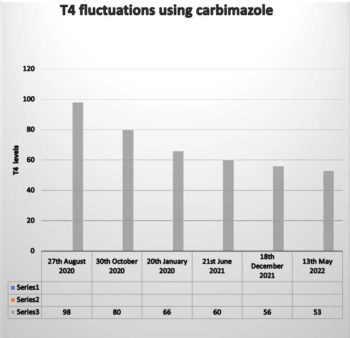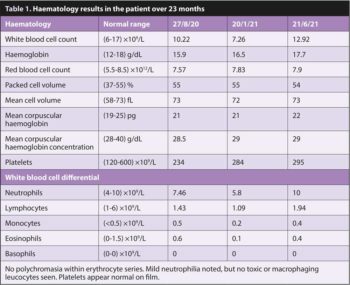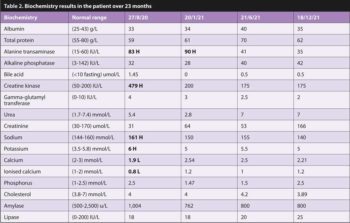7 Oct 2022
Mónica Guerrero Méndez, MRCVS, outlines her successful approach to treating this condition in an eight-year-old female cocker spaniel.

Lucy.
Thyroid tumours are the endocrine tumours most commonly reported in general practice; this mainly affects elderly dogs. Diagnosis is generally made through clinical history, haematology and biochemistry, biopsy, fine needle aspiration, radiograph and CT scans. Surgical excision is the treatment of choice whenever possible, complemented by coadjuvant chemotherapy or radiotherapy; however, the prognosis is poor in most cases. Palliative treatment using methimazole has been used in a small percentage, for which median life expectancy is reported to be 15 months.
In this article, the author describes how she treated hyperthyroidism in a dog with a cervical mass using only carbimazole – a drug not currently licensed for use in dogs. The author’s patient was showing marked signs of hyperthyroidism that were normalised over 23 months by the administration of carbimazole once daily, starting at 30mg/day and reducing in stages to 15mg/day. This case demonstrates that the use of carbimazole is a new and effective option for controlling hormone levels and clinical signs of hyperthyroidism in dogs when surgery is not possible.
Common presentations of endocrine tumours in dogs include tumours of the thyroid gland, parathyroid gland, pituitary gland, adrenal glands and endocrine pancreas.
Thyroid tumours are one of the most common endocrine tumours seen in general practice. They are more commonly reported in elderly dogs (10 years of age or older), and breeds at increased risk include the boxer, beagle and golden retriever.
A cervical growing mass is normally the most characteristic sign, and patients may exhibit dyspnoea, coughing, dysphagia, retching, anorexia and dysphonia. At least 70% of these tumours are malignant and detected as carcinomas.

The majority of dogs with a thyroid carcinoma are euthyroid; however, in 20% of cases, thyroid carcinomas are functional, producing an excessive concentration of the thyroid hormone in plasma and presenting the associated clinical signs of hyperthyroidism, such as polyuria, polydipsia, polyphagia, weight loss and tachycardia. Cardiac arrhythmia/heart murmurs may be detected in some cases.
Hypothyroidism due to the destruction of normal thyroid tissue by a malignant tumour has only been reported in 6% to 20% of cases.
Canine thyroid carcinomas are characterised by local tissue invasion and a high rate of metastasis to the lungs, retropharyngeal lymph nodes, and liver.
Methods of thyroid tumour diagnosis include:
Among the different treatment options for thyroid carcinoma in dogs, surgical resection is the first choice regardless of the functional status of the tumour. Freely movable masses (most commonly adenomas) are surgically easier to remove than infiltrating carcinomas, which are usually malignant.
Thyroid tumours are extremely vascular, and the proximity of laryngeal nerves, parathyroid glands and major vessels make this a procedure that needs to be carried out by an experienced surgeon.

The median survival time of patients that had successful surgery with no obvious signs of metastasis is more than 36 months, according to a study carried out by Scharf et al (2020). Patients that undergo surgery with an extensive carcinoma and metastasis should also undergo adjunctive chemotherapy, and palliative radiation therapy or radioiodine therapy.
Chemotherapy alone does not grant total remission of thyroid carcinoma and no strong evidence exists that supports its use.
Radiotherapy (external beam radiation therapy) is only effective for local control of unresectable thyroid tumours; however, it does not prevent metastasis and can cause acute complications, such as laryngitis, oesophagitis, skin changes and hypothyroidism. The survival rate using radiotherapy is one year.
Lastly, iodine treatment has been confirmed as a viable alternative to radiation therapy for dogs in which the carcinoma concentrates radioiodine based on nuclear scintigraphy. Studies have shown that median survival time in dogs undergoing iodine therapy ranges from 1 to 2.5 years, making it a viable treatment.
The prognosis of canine thyroid carcinomas is guarded in all cases.
In this article, the author will discuss the use of carbimazole (Vidalta; MSD Animal Health UK) as the only palliative treatment that has successfully controlled the clinical signs of hyperthyroidism and improved the quality of life for a hyperthyroid canine patient that developed a unilateral mass on the left cervical area, which was reported in 2020.
The patient, named Lucy, was then an eight‑year‑old neutered female cocker spaniel who had just been rehomed during lockdown and was presented to the author for a full clinical examination.
On examination, Lucy was lethargic and listless. Polyuria and polydipsia were reported by the owner. Her bodyweight was recorded at 8kg. Her fur was very dry and dull; eyes were bright; no obvious abnormalities were reported in the head/face area. Her teeth had a small amount of tartar buildup. Her mucous membranes were pink, with a normal capillary refill time. Her lymph nodes all over the body were within a normal size; however, her thyroid gland felt slightly larger on the left cervical area, making the author think that a thyroid tumour could be developing.
Mild tachycardia was reported on heart auscultation with a heart rate recorded at 140bpm. No obvious heart murmur was reported on further heart auscultation. The chest sounded clear on auscultation. Abdominal palpation was unremarkable. A rectal temperature was recorded at 37.5°C. The new owner reported some occasional vomiting and intermittent diarrhoea, but the patient had just been rehomed, so this was not necessarily unusual.
A blood sample was collected for full haematology and biochemistry profiles, including serology of the thyroid hormone.
A presumptive differential diagnosis with a thyroid tumour/hyperthyroidism was made after clinical examination and considering the clinical signs.
On biochemistry, the alanine aminotransferase, creatinine kinase, sodium and potassium were raised, while total calcium and ionised calcium were slightly low – this could have been due to mild dehydration or parathyroid gland involvement; however, the parathyroid gland was not assessed.
The T4 was very high at 98nmol/L (normal range is 25.7nmol/L to 53nmol/L). The patient was displaying obvious clinical signs of hyperthyroidism.
A further appointment was arranged to discuss the results with the owner and the next plan of action.
Ultrasound/CT scans/chest radiographs, fine needle aspiration and surgery, and chemotherapy/radiotherapy were some of the options discussed – these being the most common protocols to follow in such cases. However, as this was during lockdown, these options were more problematic than usual.
The owner decided he wanted a minimally invasive approach, so, given this limitation, the author decided to treat the patient’s hyperthyroidism with drugs even though she had not tried this approach before.
The author’s results using carbimazole in hyperthyroidism in cats had been excellent, so she decided to treat the patient with carbimazole, even though it is not licensed for use in dogs.

Given that the T4 was so high, the initial dose the author decided on was 30mg carbimazole once daily, with a view to rechecking the levels three to four weeks later to assess progress. Haematology was unremarkable; full haematology/biochemistry would be carried out every three months. See Tables 1 and 2 for blood test results.
The T4 had reduced from 98nmol/L to 80nmol/L. The patient was reported to be much more active, and her fur was not so dull and dry. Her bodyweight was recorded at 9kg and stools were normal.
No obvious side effects were noticeable using carbimazole, so the author kept the patient on 30mg once daily. Another blood test was scheduled for two months later.
The patient was thriving very well; she had maintained her weight, and her coat was shiny and in very nice condition. Her heart rate was 100bpm.
The mass on the left cervical area had not increased in size. The patient was extremely active. A blood sample was collected for full haematology/biochemistry and T4.
Haematology and biochemistry were unremarkable. The T4 had continued to decrease to 66nmol/L. At this point, the author decided to adjust the patient’s dose to 15mg carbimazole once daily, with periodical blood tests every four to five months, unless anything changed.
Haematology and biochemistry continued to be unremarkable. The T4 had decreased from 66nmol/L to 60nmol/L, even with the carbimazole dose reduced by half.
The patient was very well in herself with a good quality of life; however, the tumour had increased in size to about 2cm in diameter. No side effects due to carbimazole usage were reported.
Only serology was carried out this time and the T4 continued decreasing from 60nmol/L to 56nmol/L – almost within the normal range.
The thyroid mass remained the same size and the patient was well in herself.
Only serology was carried out this time again and the T4 had decreased from 56nmol/L to 53nmol/L, reaching a normal level.
The patient will continue on 15mg carbimazole once daily until a full blood test in November. The patient is very well in herself with a good quality of life and the thyroid mass is not affecting her currently.
See Figure 1 for consistent reduction of T4 hormone over almost two years with the use of carbimazole. The patient’s prognosis 23 months post-treatment is good. See Tables 1 and 2 for haematology and biochemistry results over 23 months.
Thyroid tumours are the most common endocrine tumours in dogs. Only 10% of dogs with a thyroid tumour will show clinical signs of hyperthyroidism; however, in this case, the author’s patient had marked signs of hyperthyroidism, presumably linked to a free movable mass on her left cervical area.
According to the literature published, and the feedback the author recorded when she contacted all the oncology referral centres in the UK while gathering her data, surgical excision of the tumour is generally the treatment of choice followed by chemotherapy/radiotherapy or iodine treatment; due to the nature of these tumours, which are usually malignant, metastasis to the lungs and the lymphatic system is very common.
It has been published that a dog with a free movable mass will have a longer life expectancy than a dog with a non-defined attached tumour, since free movable thyroid tumours tend to be benign (adenomas) and attached tumours are generally carcinomas.
Thyroid medication (methimazole) is the only thyroid-regulating drug that has ever been used in dogs, and then only occasionally and in a very small percentage of patients where the T4 levels were elevated due to the thyroid tumour being functional; methimazole was used to normalise T4 parameters before surgery was carried out.

Vidalta (carbimazole), which is not currently licensed for dogs, is a new thyroid regulating drug developed to treat hyperthyroidism in cats by medicating only once daily, as opposed to methimazole, which is given twice daily. The difference between the two drugs is that carbimazole is a prodrug, bigger than methimazole, which gets converted into methimazole through enzymatic action, and provides approximately 25% more available methimazole after conversion to the active metabolite, lasting longer in the body with a single dose.
Carbimazole is also known for having fewer side effects long-term than methimazole.
As the author had achieved excellent results using carbimazole in cats, she decided to use it to treat her patient, even though it had not been trialled in dogs, since the owner only wanted palliative treatment given the lockdown restrictions at the time.
Carbimazole usage on this occasion controlled the author’s patient’s hyperthyroidism.

Several blood tests were carried out since the treatment started and, in Figure 1, a steady decrease in T4 can be observed over a 22-month period. The initial dose was high for the first 3 months at 30mg once daily; this was reduced to 15mg once daily and continues to the present time.
The patient has shown no side effects with carbimazole and has a great quality of life at present.
The median survival time for dogs with a functional thyroid tumour without undergoing surgery is recorded at 15 months; the author’s patient’s survival time is 23 months at the time of writing, making the use of carbimazole in hyperthyroid dogs a new and effective option for controlling hormone levels and clinical signs when surgery is not possible.